1976 Belgian Grand Prix race report: A Ferrari enthusiast's delight
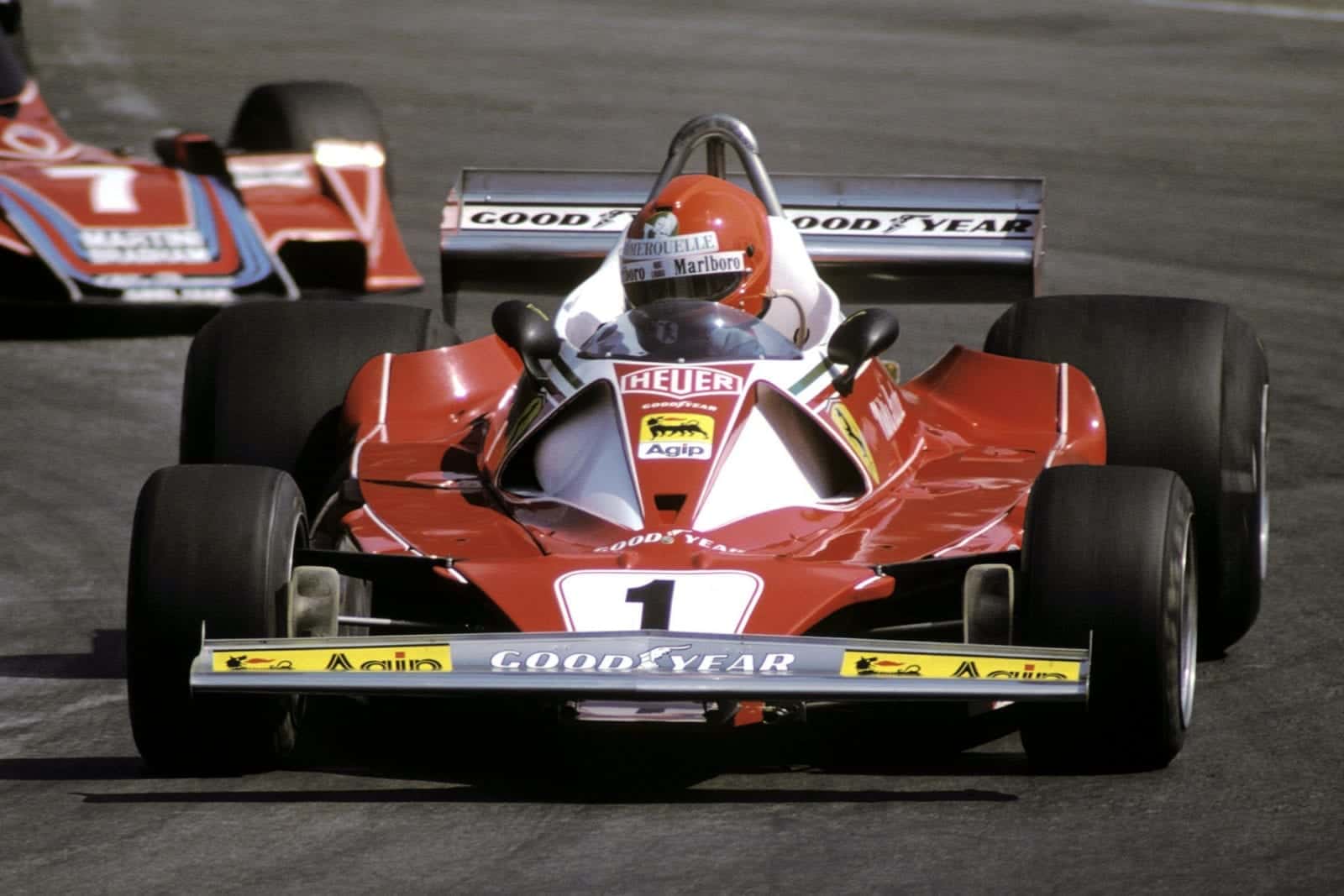
Niki Lauda claimed a third win of 1976 at Zolder
Motorsport Images
Zolder, Belgium, May 16th
It is interesting how time heals and you can get used to anything, for the Belgian Grand Prix was making its third visit to the little Zolder circuit in the Province of Limburg, yet it was only in 1973 that everyone stormed off from the circuit hoping never to return. The following year the “circus” settled happily at Nivelles-Baulers, but that great edifice subsided in financial ruin and a return was made to Zolder. Second time round everything was much better and all went well, so that everyone was happy to return to the little track once more, even though it resembles a Go-Kart circuit for 500 b.h.p. Formula One cars, in contrast to somewhere like Nürburgring or Monza. Its stop-startstop characteristics are very hard on brakes, even though there is no really heavy braking from ultra-high speed. It is not so much that there is anything particularly wrong with Zolder, it is just that there is not very much right with it, from the point of view of Grand Prix racing. For Formula One entertainment it is adequate and about all that some drivers and cars deserve, and if they do not know any better it is their loss, but there are better places for Grand Prix cars to run and for Grand Prix drivers to show their skill and ability. It is not the sort of place to set the adrenalin flowing in driver or spectator, but as it was warm and sunny it was enjoyable.
Qualifying
Some of the teams had already been “testing” at Zolder, while others were new to the place but it did not take long for everyone to get into the swing of things and the “roundy-round” of practice, though some did not go for very long. Lauda’s T2 Ferrari swallowed part of its injection system so he spent the rest of the day driving the uprated T1 car and similarly, Tom Pryce spent most of the day in the spare Shadow after his Cosworth engine broke in his normal car. With repositioned oil coolers on his McLaren, Jochen Mass was being troubled by overheating and Watson had the second Penske, with “chisel” nose cowling, die on him with fuel-feed trouble, so he continued in the spare older car with March-like front cowling. The Fittipaldi team had not really recovered from their Spanish debacle and a shortage of spare engines meant they could only run one car for Emerson Fittipaldi, keeping Hoffman’s car as a stand-by. The Ligier-Matra was going well and Laffite was on good form, while Hunt was out to make amends for his Spanish disqualification and was setting the pace, ending the morning session in a class of his own with a time of 1 min. 26.74 sec., no-one else being in the one-twenty-six bracket. The two six-wheeled Tyrrell cars were demonstrating that the idea was serious, Scheckter getting into the feel of the car very quickly and with Depailler one-hundredth of a second behind him he was third fastest of the morning session, behind Regazzoni who was upholding the Ferrari honours while his team-mate was in trouble. The Brabham team were experimenting with different types of air box, without making much apparent improvement, but Amon, running the new Ensign without an air box, was up among the front-runners.
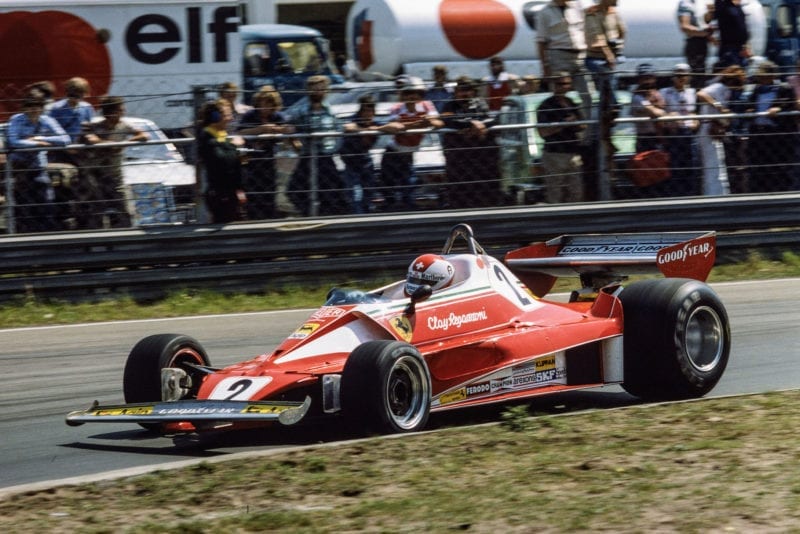
Clay Regazzoni put his Ferrari second behind team-mate Lauda on the grid
Motorsport Images
A break after the morning hour-and-a-half of practice was very welcome on this busy little circuit with its overcrowded and cramped pit area, and during the hour of afternoon practice a pattern began to appear that surprised no-one, though it upset some who had hoped to change the pattern. Regazzoni led the Ferrari onslaught, closely followed by Lauda still in the spare car, but Depailler and Brambilla joined them in the elite 1min 26sec group. Hunt was in trouble with gear selection on his Hewland/McLaren sixspeed gearbox and did hardly any laps at all and could not repeat his morning performance, while the overheating and oil cooler troubles on Mass’ car kept him in the pits for most of the time. The leading group of pacesetters was clearly moving into a class of its own, while the hard-triers were in the onetwenty-seven bracket. There were some hopefuls in the one-twenty-eights, a lot of medium runners in the one-twenty-nines and one minute thirty seconds or over had to be for the “no-hopers”, especially as the starting grid was limited to 26 cars and there were 29 drivers practicing. Down in this bottom group was Gunnar Nilsson for no clearly definable reason other than minor irritating troubles with the Lotus and an inability to get into the rhythm of the circuit.
Next day, Saturday, it all started up again for an-hour-and-a-half in the morning and with a new engine in his T2 Ferrari Lauda got himself up to the front. This was an untimed session, principally for scrubbing in tyres ready for race day and doing suspension adjustments for running with full fuel loads and generally getting prepared for starting the race in the right conditions. On the previous day Pace had crashed the Brabham-Alfa Romeo BT45/3 and crumpled the monocoque against the catch-fence posts, so he was settling into the spare car. Hunt was having a bit of a go to make up for lost time and found the absolute limit on one of the right-hand bends as he spun backwards off the track and into the catch fences. He was unhurt and not even shaken, knowing full well why it had happened, and was soon out again in the spare McLaren, which was not really race-worthy as it had been robbed of various bits for Mass’ car.
In the final hour of practice, on Saturday afternoon, there was a bit of a mad scramble, with little hope of anyone getting a clear run, for those near the front were hoping to oust the Ferraris from the front of the grid, those at the back were trying desperately not to be the last three, and those in the middle were trying not to get left behind by the leaders or caught up with by the tail-enders. From a combination of overcrowding, limited-time panics, various troubles and a continual use of the track (for when the F1 cars were not out hordes of Renault R5 saloons and Renault-engined single-seaters were practising or racing) the overall pace was getting slower, even though weather conditions were getting better all the time. Consequently, Lauda was the only one to do an “elite” time and poor Hunt could do nothing to challenge him because the engine in the spare McLaren refused to rev over 10,000 r.p.m. and was troublesome to start. It was the one he used to finish first in Spain and it was doing service as an emergency spare before its next overhaul.
Race
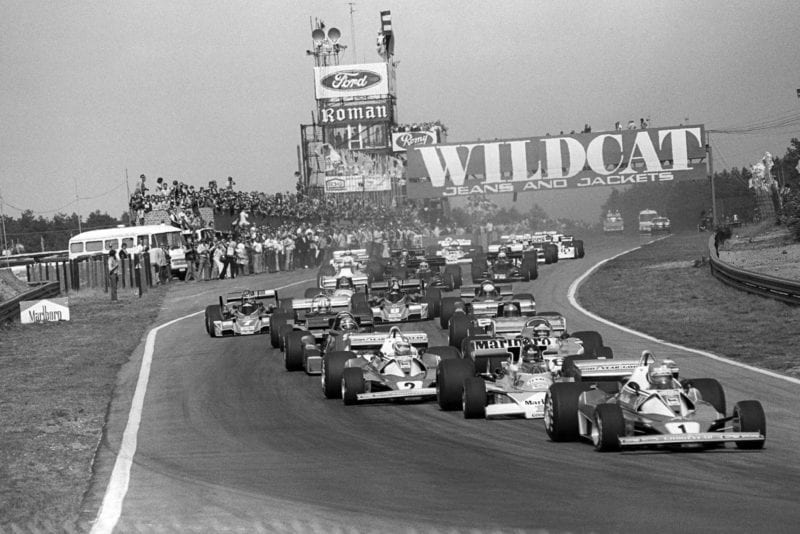
The cars head into Turn 1
Motorsport Images
When the whirling-round eventually subsided and the timekeepers sorted out all their facts and figures Lauda and Regazzoni were on the front row of the grid, with the World Champion in pole position, and Hunt and Depailler were behind them. Hunt’s original car M23/8 was slightly crinkled so M23/6 was given a new engine and prepared for the race, taking its place on the second row thanks to the time recorded by M23/8. The hard-trying Depailler was alongside with the six-wheeled Tyrrell P34/2 and in row three were Laffite with the Ligier-Matra V12 and Brambilla with the orange March. It was beginning to look as if the “orthodox British kit-car” was finished and if you did not have 12 cylinders then you needed an innovation to add to your Cosworth/ Hewland kit-car to make it competitive, such as six wheels or six speeds in the gearbox (or you needed a hard-charger in the cockpit!). Ecclestone’s Brabham team were giving the others encouragement by showing that even with 12 cylinders you could not guarantee to be competitive. On the fourth row of the grid was Amon with the neat and unobtrusive Ensign, illustrating perhaps that if all the factors are above average, with no weak points and, equally, no strong points., you can be well placed without too much drama or expense. In contrast the Walter Wolf-financed Williams team were showing that sheer expense was no short cut to success, for they scraped one car on to the last row of the grid, driven by Leclerc, while Ickx did not qualify. A very dejected Emerson Fittipaldi was also o nonqualifier which was a surprise, unless you had noticed the way the car had been handling during practice, for it never Seemed to go where the driver wanted it to go or even thought it was going to go. The other nonqualifier was Guy Edwards with the Rent-a-Drive Hesketh, but that was no surprise to anyone, except perhaps the people who had paid for the car.
The race was not due to start until 3 p.m. on Sunday so a quick 20-minute whizz-round in the morning gave everyone time for lunch before the serious business began. Behind the main grandstands some 70 road-going Ferraris were arriving, from a Ferrari Clubs gathering, all the owners smiling happily when they saw the starting order for the race with Lauda and Regazzoni on the front row. An equally large number of “First National City Bank Travellers Cheques” guests were also arriving and the Penske team were relieved that their car was on the grid, even it if was difficult to pick out down in row nine. The Brazilian media men were sitting around gloomily, wondering how they were going to explain the demise of the Copersucar-backed ex-World Champion, who had packed up and gone home in despair. Jacky Ickx was in the paddock trying to keep a brave face in front of newshounds who could not understand why he was not in his own National Grand Prix and as 3 p.m. approached the skies were clear, a breeze was blowing as a headwind on the pits straight and all was set for a great race, providing you were a Ferrari enthusiast. The distance was 70 laps, which sounded a lot, but in fact would only represent 1 1/2 hours of racing, and well on schedule Lauda and Regazzoni led the field forward to the grid. The starter waited for the tail-enders to sort themselves out and then pressed his button! A rather undramatic set of red lights glowed on the bridge ahead of the start-line and after ten seconds they disappeared and a green set glowed and Lauda was gone. Hunt made a good start from the second row and was alongside Regazzoni as they raced for the first corner, which Hunt took from the inside and was into second place behind the World Champion. All 26 cars got away well and strung out round the big loop before reappearing up the back straight in the order Lauda, Hunt, Regazzoni, Laffite, Brambilla, Depailler, Amon with a jostling crowd behind them.
To the joy of the Ferrari enthusiasts Niki Lauda waited for no-one and before the dust of the start had settled he was already pulling out a visible lead. From his pole position he had only one objective-and that was to win the race, for himself and for “the Ferrari”, which means Enzo Ferrari, Mauro Forghieri, his chief mechanic Ermano Cuoghi, all the team members at the race and all those people back in Maranello who keep the team ping. As he drew steadily away driving smoothly and without flurry one was reminded of the great Ferrari era of Alberto Ascari, the opposition just melted away in his rear-view mirrors. If anyone was thinking that Lauda was unfit and would not stand the pace, they would have to think again. Uncomfortable he may still be, but not unfit, physically or mentally. Behind him Hunt was doing a good job leading Regazzoni in the second Ferrari, Laffite in the screaming Ligier-Matra, Depailler in a sixwheeled Tyrrell, Scheckter in a similar car. Amon in the works Ensign, the two Brabham-Alfas of Pace and Reutemann, then Peterson in the blue and yellow March, the black Shadow of Janet, the black and gold Lotus of Andretti, the white March of Stuck and the orange one of Brambilla. The Italian had been in fifth place in the opening rush but he got all crossed-up on lap 4 and dropped back to fourteenth place. Two-and-a-half laps later a rear hub shaft sheared as he was going into the chicane behind the paddock and he was off the track in a cloud of sand and out of the race. A short while later Nilsson stopped just before the pits with his throttle slides jammed shut with dirt after an excursion into the rough stuff, unfortunately parking the car on the opposite side of the track from any possible help from his mechanics. Just as this was happening Regazzoni decided he ought to support the flying Lauda, and took second place from Hunt and that was the end of anyone else getting a look in, the two Ferraris powered away into an unassailable lead.
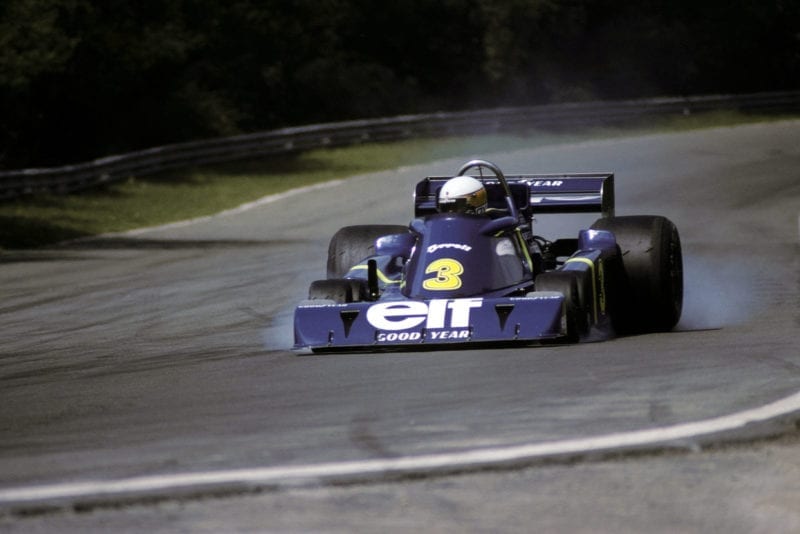
Jody Scheckter finished 4th in his six-wheeler Tyrrell
Motorsport Images
Hunt’s car was nothing like on form and he was having trouble keeping ahead of Depailler who had got past the Ligier. At 10 laps the order was Lauda, Regazzoni, Hunt, Depailler, Laffite, Scheckter and Amon, the queue for third place being nose-to-tail behind the McLaren. Then came Andretti, having passed Peterson, Reutemann and Pace and moving up into this group were Alan Jones and Jochen Mass. The Lotus disappeared into the pits five laps later with dust and dirt in the fuel injection and two laps later Reutemann’s Alfa Romeo engine lost all its oil pressure and as he slowed violently Peterson dodged to the wrong side and found himself having a private accident among the catch-fences! It was March A-team two down and the B-team with one to go, as Merzario was on his way out with a sick engine. Laffite forced his way by Hunt on lap 17 and collected a big black tyre mark on the right of the Ligier cockpit from the McLaren’s front wheel, for Hunt was not going to let “a frog” go by that easily, but on the next lap Depailler got his six-wheeler past the McLaren. We now had a flat-12-cylinder Italian car in the lead, another in second place, a V12-cylinder French car in third place and a six-wheeled British car in fourth place. and people think all Formula One cars are the same!
As Depailler went by the pits to start lap 29 his engine made an awful noise and that was the last we saw of him, the Cosworth V8 rout was complete. The two Ferraris and the LigierMatra sang their 12-cylindered way round the circuit, reeling off the laps with complete reliability, while behind them the British cars fell apart or failed to keep up. Hunt’s gearbox was losing oil and it was only a matter of’ time before his race was over, Scheckter’s rear suspension had a broken link-mounting due to a blow “from a kerb that stepped out” or a passing car, and Amon was in a worthy fifth place with the Ensign until the left-rear wheel came adrift on lap 52 and he crashed spectacularly but the strong roll-over bar saved him from serious injury. Andretti rejoined the race for a while, until a drive-shaft joint broke up, Stuck went out with damaged rear suspension, and Ertl’s Cosworth engine broke in the white Hesketh. Pace’s Alfa Romeo engine died on him with electrical failure as he passed the pits, and Lunger’s Surtees set itself on fire when the ignition rotor broke up and ignited a fuel leak in the injection system. All this time Jones had been circulating regularly, and moved up into fifth place, Mass had worked his way up into sixth and Perkins had battled his way past both the Shadows to take eighth place behind Watson.
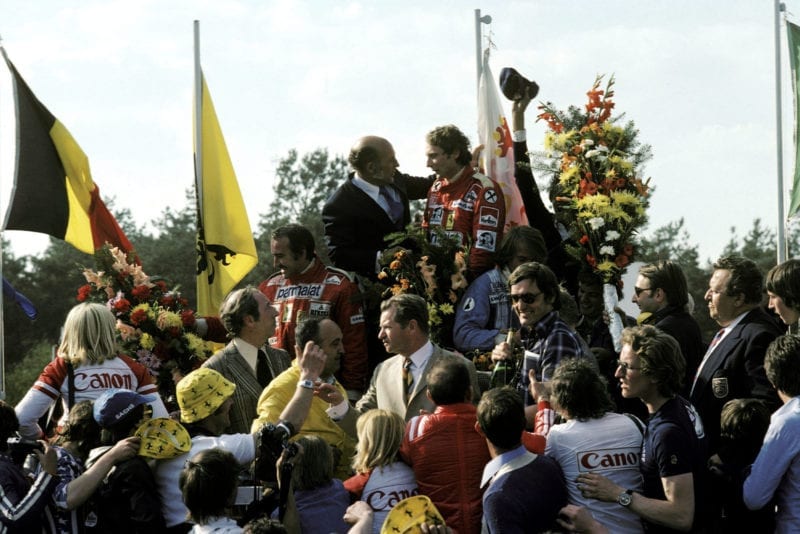
Lauda celebrates on the podium
Motorsport Images
Although the gaps between the first three cars varied now and then due to back-markers holding things up as they were lapped, the three 12-cylinder cars never missed a beat and had the race been another couple of laps longer the CosworthKit-Car annihilation would have been complete, for Lauda would have lapped Scheckter’s Tyrrell, which crossed the line to all intents and purposes a lap in arrears on the Ferraris, its pace slowed by the excessive lean-in of the right rear wheel. Scheckter had done well to finish.
A lot of Ferrari enthusiasts left the Zolder circuit with smug looks on their faces, as well they might, and there was great rejoicing in Modena.—D.S.J.
